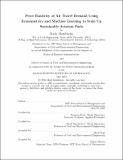Price Elasticity of Air Travel Demand Using Econometrics and Machine Learning to Scale Up Sustainable Aviation Fuels
Author(s)
Membreno, Mark
DownloadThesis PDF (4.050Mb)
Advisor
Kala, Namrata
Simchi-Levi, David
Terms of use
Metadata
Show full item recordAbstract
This study seeks to estimate the price elasticity of aviation travel demand. These insights will be used to integrate Sustainable Aviation Fuels (SAF) strategically to aid in decarbonizing the aviation industry. Econometric and machine learning models were applied to historical air travel data to see how airfare prices influence travel demand, focusing on the economy and business passenger segments. Different route segmentations were explored to gather insights into how price affects travel demand in these route segments. The models consider predictors such as GDP, oil prices, population, time of year, and other socio-economic variables to predict passenger count. The econometric models were fitted to data prior to COVID-19 since passenger behavior prior to the disruption is a better indicator for travel today. Two sets of machine learning models were trained using both data before COVID-19 and the available time frame from 2016 to 2023. The predictive accuracy of both models performed well, with the average R2 for economy and business passengers being 0.95 and 0.87, respectively. The 2SLS’s instrumental variable (IV) of oil price has been shown as weak. For most of the fitted models, the IV’s coefficients do not have a significant relationship with the endogenous variable of price in the first stage. The price elasticity values for this study show how passenger count is affected based on a 1% increase in airfare price. The econometric models can directly interpret price elasticity from their fitted coefficients based on the theory of log transforming the data. The business passenger segment’s price elasticity values ranged between 0 to-1%, indicating they are less price sensitive due to the necessity of their travels or have higher income. However, the price elasticity for economy passengers was centered around 0 and even positive in some route segments. This is counterintuitive as economy passengers are typically more price sensitive than business passengers, corresponding to price elasticity values less than 1%. 3Future recommendations to improve the models’ estimations of price elasticities. The fixed effects applied to the data set and a more granular data exploration can leverage more accurate predictors of the relationship between price and travel demand.
Date issued
2024-05Department
Sloan School of Management; Massachusetts Institute of Technology. Department of Civil and Environmental EngineeringPublisher
Massachusetts Institute of Technology